November 2021
November 15, 2021
Jello Brainwaves
In 1974, Dr. Adrian Upton of McMaster University placed E.E.G. electrodes on a blob of lime jello and obtained positive readings. This indicated brain activity. He published his results in 1976 in the Medical Tribune.Upton was trying to demonstrate that when doctors use an E.E.G. to determine brain death, it can be difficult to obtain a perfectly flat readout, because the equipment picks up stray electrical activity from the surrounding environment. Or maybe he had discovered that jello is a sentient lifeform.
The Jell-O Gallery Museum in Le Roy, New York seems to prefer the latter conclusion. A brain-shaped jello mold on display at the museum bears the message: "A Bowl of Jell-O Gelatin and the Human Brain Have the Same Frequency of Brain Waves."

image source: Donna Goldstein, researchgate.net
More info: The Straight Dope


Wichita Eagle - Mar 8, 1976
Posted By: Alex - Mon Nov 15, 2021 -
Comments (7)
Category: Food, Jello, Experiments, 1970s, Brain
Terry Head and Gisela
It's not every day that one sees a mime-skating-comedy act.Another clip of the act, not embeddable, here on a Facebook page.
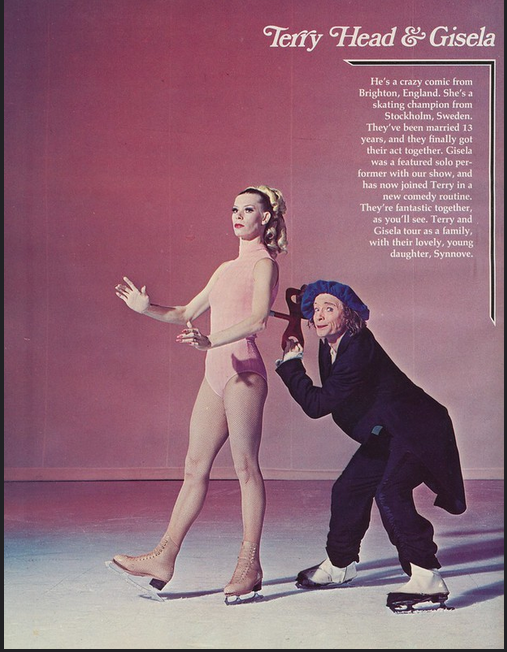
Posted By: Paul - Mon Nov 15, 2021 -
Comments (0)
Category: Humor, Puppets and Automatons, Skating, Sledding, Skiing and Other Wintertime Pursuits, 1970s
November 14, 2021
The Blonde Brigade
Apr 1938: Actress Jean Colwell came up with a sure-fire way to end all wars. Her idea was that if a group of beautiful, blonde women stood in between the two opposing armies, in the "no man's land," then the soldiers on each side would refuse to attack because "No soldier will shoot at a good-looking blonde." Peace would be achieved!To make her vision a reality, Colwell placed an ad in a New York newspaper:
The response was enthusiastic, and within a month she had enough volunteers to form a "blonde brigade," all wiling to risk their lives for peace.
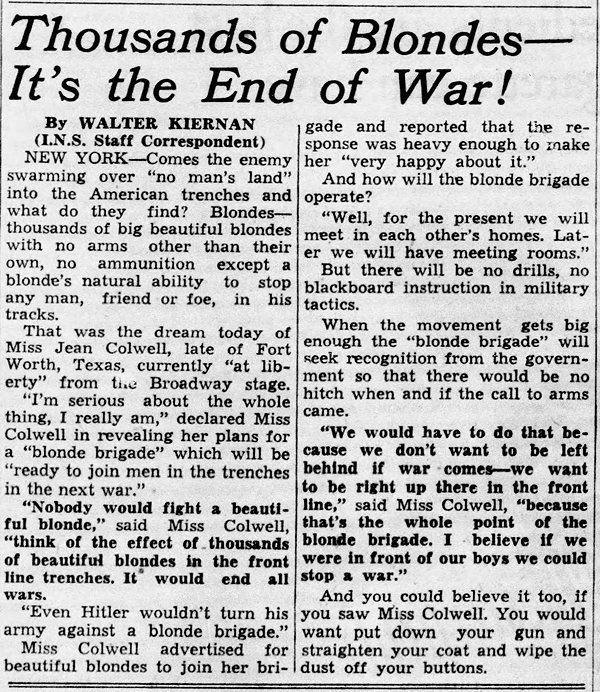
Wisconsin State Journal - Mar 29, 1938
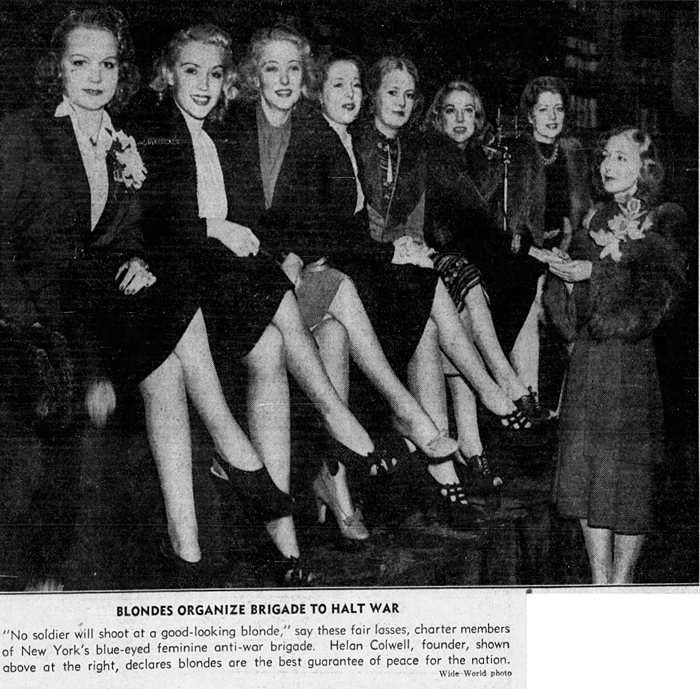
Los Angeles Times - Apr 27, 1938
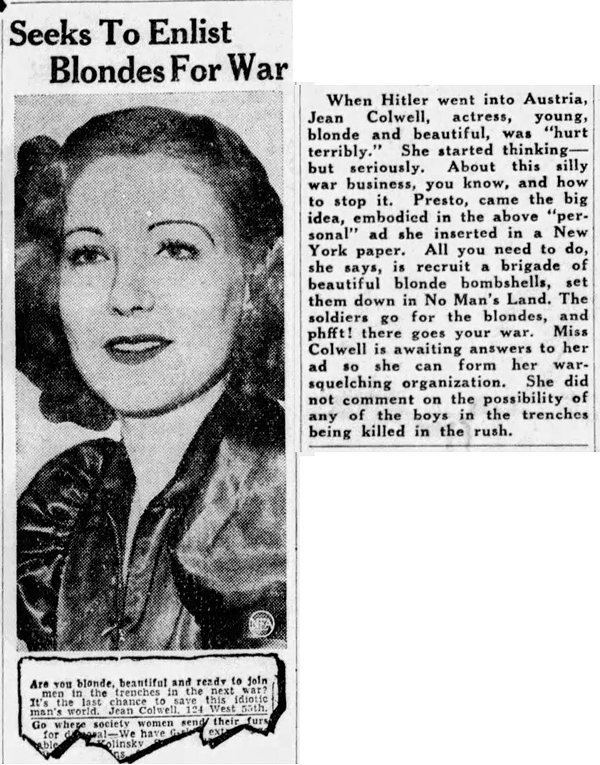
Owensboro Messenger - Apr 2, 1938
Women of other hair colors didn't want to be left out. So there was soon also a "red-headed regiment" and a "brunette battalion."
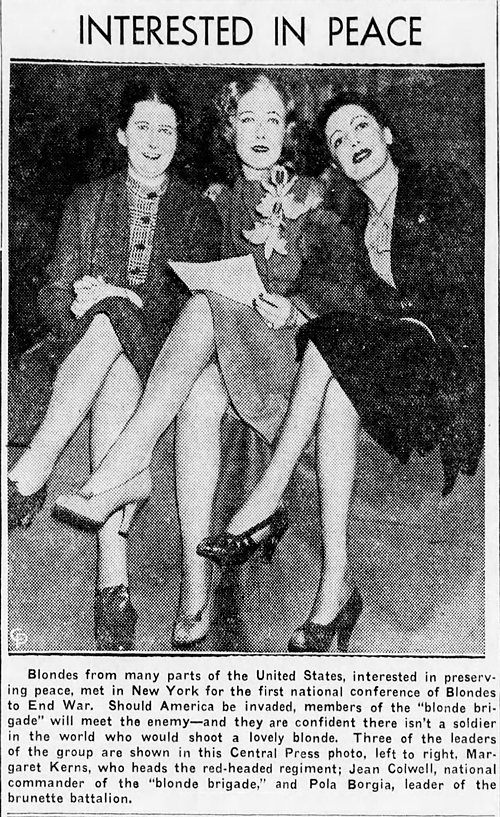
San Bernardino County Sun - Apr 30, 1938
Of course, none of these women were ever shipped to the front line to serve as a human shield. Colwell herself spent the war in Forth Worth, Texas performing in plays. After the war she moved to Japan as a civil service worker. When she died in 1986, she was back in Fort Worth. I haven't found any info on what she did between 1946 and 1986.
Posted By: Alex - Sun Nov 14, 2021 -
Comments (4)
Category: War, 1930s, Women, Hair and Hairstyling
Arabic Proverbs
I intend to salt my conversation thoroughly with the proverbs in this book.Read it here.
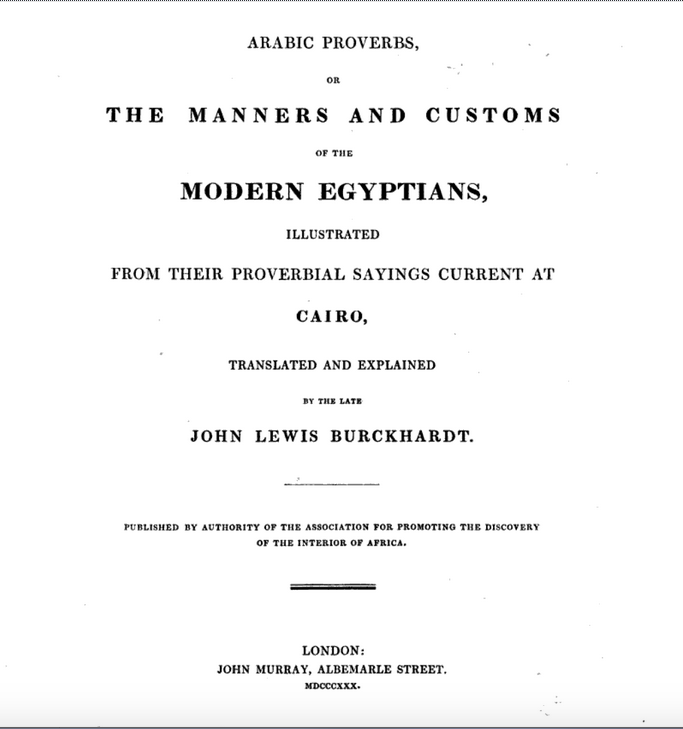

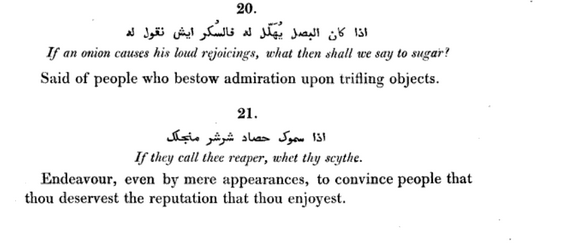

Posted By: Paul - Sun Nov 14, 2021 -
Comments (0)
Category: Religion, Proverbs, Maxims, Sayings, Folk Wisdom and Quotations, Middle East, Nineteenth Century
November 13, 2021
Crazy People
Could be the WU theme song.Info from wikipedia:
Posted By: Alex - Sat Nov 13, 2021 -
Comments (1)
Category: Music, 1930s
“Sweet Blindness:” Your Choice
Which version do you prefer? Nyro's original bouncy and exuberant one? Or Minelli's "improved" manic and hyper non-stop whirlwind one?
Posted By: Paul - Sat Nov 13, 2021 -
Comments (1)
Category: Music, Television, Homages, Pastiches, Tributes and Borrowings, 1960s
November 12, 2021
Pac-Man Hat
From Stephen Jones Millinery, Spring 2009.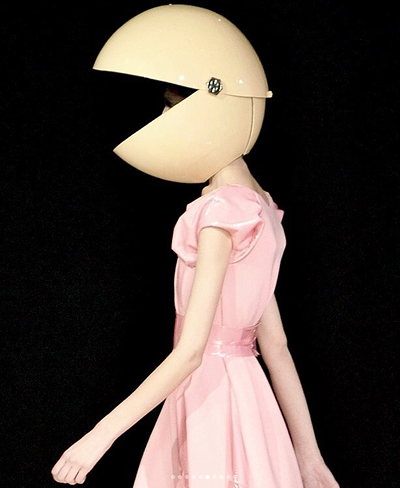

via gastt_fashion
Posted By: Alex - Fri Nov 12, 2021 -
Comments (0)
Category: Headgear, Videogames and Gamers
Moe and Shemp Go for a Swim
Unscripted poolside mayhem.
Posted By: Paul - Fri Nov 12, 2021 -
Comments (1)
Category: Swimming, Snorkeling, and Diving, 1920s, Comedians
November 11, 2021
The man who could read record grooves
Dr. Arthur Lintgen had an unusual talent. By looking at the grooves on a vinyl record, he could identify what the recording was. Within limits. It had to be classical music (no rock 'n' roll), preferably from the time of Beethoven up to the present. And it had to be a complete recording. Not an excerpt. But within those parameters, he was pretty much flawless.You can see him in action in the clip below.
Some more info from the Pittsburgh Post-Gazette (Aug 5, 1980):
Ridiculous.
My editor broke out in laughter. Colleagues howled with scorn. I just smirked a little.
Laugh no more, lest Arthur B. Lintgen M.D. make you chew on your ridicule and swallow every smirk. Lintgen indeed possesses this astonishing talent. Its value, granted, is dubious in terms of mankind's future — nothing like a cure for cancer or a peace formula for Palestinians.
But if you cherish astonishment for its own sake, then watch Lintgen first as he fondles a record, holding it perpendicularly at nose level, frowning at its surface, and then as he looks up smiling brightly: "Why, yes. This is a favorite of mine, the Rachmaninoff Second Symphony."
...
[Lintgen] shies away from the pressures of a betting situation, preferring to keep his "eccentric hobby" an affair for friends and family. He is also quick to point out that his prowess is not universal, and that there are ground rules and limitations to what he can do.
First, the music must date from the time of Beethoven up through the present, the avant-garde excluded. Lintgen cannot precisely identify music he does not know or has no sympathy for. Secondly, no solo instruments or chamber music — where groove patterns, he says, fluctuate too widely to be read. Thirdly, he must know if the recording is a complete work with a fixed number of movements. No excerpts, please.
What then follows seems to be a combination of musical and technical erudition, some inspired deductive reasoning, and something else I am at a loss to isolate — perhaps a gift not unlike the sense of perfect pitch possessed by many gifted musicians.
The Haydn Symphony, No. 100 is outside Lintgen's prescribed ground rules (too early), but we asked him to look at it anyway. The process was illuminating.
• The four bands on the record surface suggested to him the four movements of the classical symphony. This was reinforced by the patterns on band three which indicated to him the A-B-A minuet form of this genre.
• The mirror-like ⅜-inch beginning the side told him "slow, quiet introduction" for which Haydn symphonies are noted. Grooves reveal to Lintgen nothing about pitch, but they do seem to tell him a great deal about volume, timbre, and movements. "Haydn," he determined finally. "I don't know which one."
Posted By: Alex - Thu Nov 11, 2021 -
Comments (0)
Category: Human Marvels, Music, 1980s
Follies of the Madmen #519

Posted By: Paul - Thu Nov 11, 2021 -
Comments (5)
Category: Sexuality, Advertising, Twentieth Century, Double Entendres and Nudge-Nudge, Wink-Wink
| Get WU Posts by Email | |
|---|---|

| Who We Are |
|---|
| Alex Boese Alex is the creator and curator of the Museum of Hoaxes. He's also the author of various weird, non-fiction books such as Elephants on Acid. Paul Di Filippo Paul has been paid to put weird ideas into fictional form for over thirty years, in his career as a noted science fiction writer. He has recently begun blogging on many curious topics with three fellow writers at The Inferior 4+1. Chuck Shepherd Chuck is the purveyor of News of the Weird, the syndicated column which for decades has set the gold-standard for reporting on oddities and the bizarre. Our banner was drawn by the legendary underground cartoonist Rick Altergott. Contact Us |

